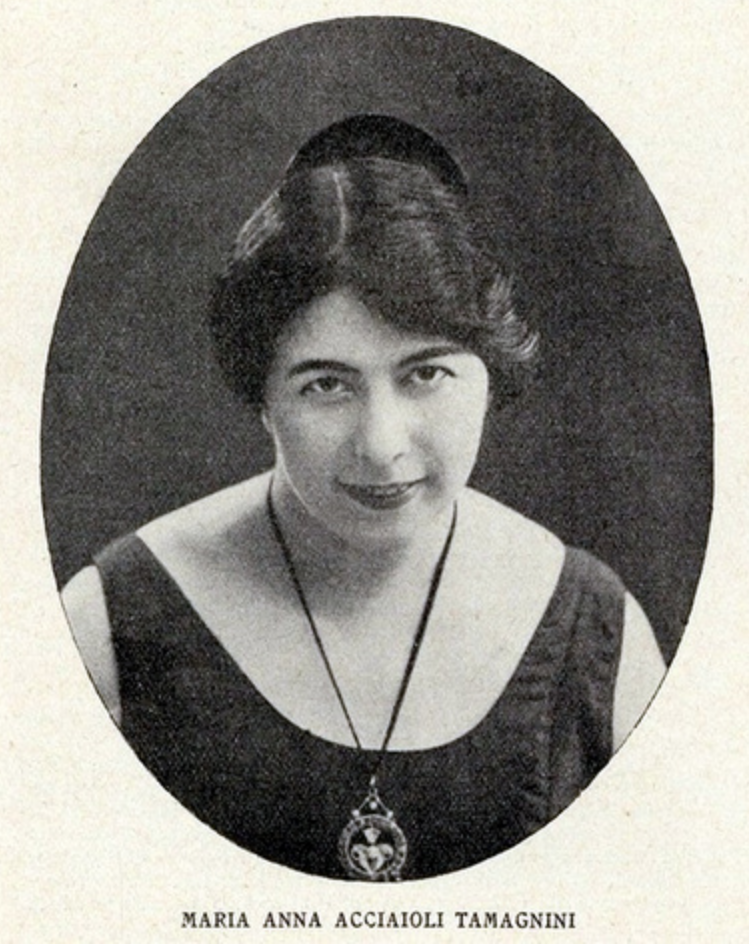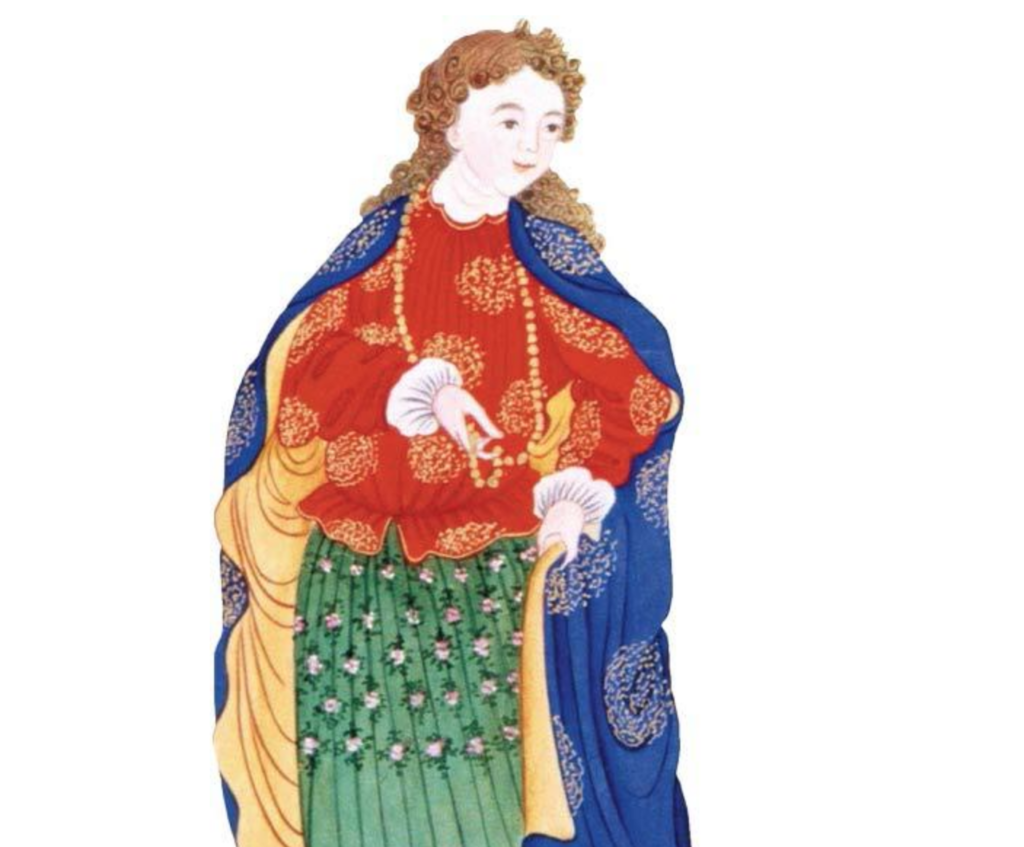Featured image: Chinese depiction of a “woman from atlantic countries”, circa 18th century. Source: Review of Culture
In March, the world celebrates International Women’s Day to show how far they’ve come, but also that there is still much to achieve. However, such a thing was unimaginable in the 17th, 18th or even the 19th century. Women were brought up in a society of patriarchy, where men were law, politics, and everything that mattered. Women were usually in the background, at home, taking care of the kids and house. However, the world is made of exceptions to this rule. This article tells the story of historic women in Macau with wealthy spouses who, contrary to most of their contemporaries, took the knowledge–books, talks, and documents—they had at home to make something of themselves, usually after the death of the man of the house.
Most of these historic women are foreigners who traveled to Macau, lived there and made a difference by creating foundations, helping social institutions. Besides becoming relevant at a community level, they’ve created a name for themselves and we won’t let them be forgotten with time. Back then, that meant they were mostly related to religious powers: be it the Clarissa sisters or the Society of Jesus, they used their influence in this area to make their way into the economic, social and commercial spheres of the Macau community. This was a clever move, no doubt.
Maria Nunes (Start of the 17th century)
Having lived and died in Macau during the 17th century, Maria Nunes and her husband–Alexandre Taveira–had a great impact on the establishment of what we know as St. Paul’s (now the Ruins of St. Paul’s). They were related to the Society of Jesus and gave large sums of money to the church and the poor. The church also included a school, to which the couple also donated a lot of money and miscellaneous items.
In a book (1974) by priest Manuel Teixeira, on important women from Macau, Maria Nunes is described as “even more generous than her husband”, having given large amounts for the construction of the chapel, church, organs, amongst other items. She was also known for giving money with no expectations of return, as well as wax for the church’s candles, towels, veils, curtains, and more. The author notes how interesting it is that, at the time, Macau had factories of organs and statues, “probably made by Chinese artists, or Japanese who were expelled from their country”. Maria Nunes is an important figure in Macau’s history precisely because she was part of the Ruins of St. Paul’s maintenance up till today. If it wasn’t for Nunes and her husband, the ruins might not even be there now.
Isabel Reigota (–1697)
Born in Japan, Isabel Reigota was ousted from her own country because of the religion she professed: Catholicism. Besides being wealthy, she was powerful and willing to help the community, even if it wasn’t her own. In the mid-17th century, Reigota and her husband established a Society of Jesus residence in China.
She used all she’d learned to gain some leverage–after her husband died–when it comes to commercial trades and negotiations regarding the Society of Jesus. She revealed herself to be a great helper when it came to the religious group’s evolution. She was also important in the trading of sandalwood between Macau and Timor and an active promoter of Jesuit missions all over Southeast Asia, namely Vietnam. Isabel Reigota was buried at the Ruins of St. Paul’s.

Oil painting portrait of Marta da Silva Merop (circa 1815). Source: Wikipedia
Marta da Silva Merop (1766–1828)
Of Chinese descent and said to have been one of Macau’s richest women, Marta da Silva Merop served as an inspiration for known writer, Austin Coates, who published a historical novel–City of Broken Promises–based on this figure. It’s said that Coates’ idea was to write a biography, but there was not enough information. She was abandoned as a baby at the Holy House of Mercy, on what was then called “the wheel”–mothers put their babies on one side and they’d be collected on the other, thus keeping the parent’s anonymity. Merop was raised by the Catholic institution, never learning to read or write. She later married East India Company’s worker and British man, Thomas Kuyck Van Mierop. He left her the remainder of his fortune before heading to London and perished on the way, in 1795. His testament read, “To my wife, I leave the sum of ten thousand pounds and my home in Rua do Hospital, as well as all its furniture”. Merop became one of the wealthiest women on the coast of China and one of the most generous benefactresses in Macau.
All this happened during the time two major prohibitions were in place: China didn’t allow European women into their territory, and the East India Company forbade their employees from marrying “indigenous” women–which included Asians. Marta regarded both Macau and Portugal as her home: proof of it was the fact that she never left the region, but also contributed greatly to aid the country. In 1805, she donated MOP $1,000, while the local governor gave MOP $500. Upon her death, Marta Merop left incredibly large sums of money to various local institutions, including the St. Francis Convent, but also MOP $20,000 to her first home, the Holy House of Mercy, and the same amount to the pupils of St. Rosa de Lima (plus MOP $200 more for each when they got married). This donation greatly impacted the Holy House of Mercy’s finances, thus the decision of hanging a portrait of the benefactress on their walls and which can still be seen until today.

Portrait of Harriet Low (1833), by George Chinnery. Exhibited at the Peabody Essex Museum. Source: Wikipedia
Harriet Low (1809–1877)
Born and raised in Massachusetts, USA, Harriet Low departed from her parents’ house in May 1829 to arrive in Macau after five months of travel. Low kept a diary when she wrote about her trip to the then Portuguese colony, titled “Lights and Shadows in the Life in Macau of a Single Woman Traveling”. According to a paper published by Rosmarie Wank-Nolasco Lamas, Harriet Low was what we call a WASP (“white, anglo-Saxon, protestant”), proud of the USA’s independence from the British crown.
She traveled to Macau with an uncle of hers and his wife and descended from a family of traders–mainly of products from the Orient. At the time, she and her aunt were living in Macau, since Chinese authorities didn’t allow women into Canton, only men. The latter would go into Macau to see their families, seek female company or just blow off some steam. “They seem as though they were just let loose from a cage, when they come down for a day or two, all life and spirits.”, Low writes in her diary regarding this matter.
Low didn’t share the same religious beliefs as most of the other women we feature, but she’s a historic figure in Macau’s history because of her audacity and way of thinking: in a men’s world, she was one of the only single North American woman living in the city, which fostered rumors. She couldn’t have put it better, “It is the fate of spinsters to be the subject of speculation”, talking about the fact of being single within a small community of the 19th century. The literature lover is a great example of woman power back in the day when most did what they were told and assumed a submissive relationship and position at home. Low decided not to rebel, but to question the powers in place when it comes to women, assuming females can be more than just mere mothers or chiefs of the household. This matter is well explored in Nolasco Lamas’ article, which you can access here.
Mother Teresa Lucian (1845–1909)
Having dedicated her life to the Catholic church and the poor, this Italian-born woman is believed to have been Macau’s first Mother Superior. Teresa Lucian is said to have found her life purpose while still living in her hometown, Trento. Upon listening to a teacher talking of the poverty some Chinese children lived in, she immediately decided she’d go to the other side of the world and help them. Dying in 1909, she dedicated 33 years of her life to this cause: first in Hong Kong–where for seven years she learned languages and took care of the Portuguese kids’ orphanage–then moving to Macau, where she greatly contributed to appease the community during the terrible epidemic that hit the city in 1895. Lucian took the wheel and reopened a school, an asylum for young girls and a creche for abandoned children. Although low on cash, she was able to go on with this plan.
Unfortunately, the then Superior Mother fell sick, but before death could take her, she experienced a situation that mostly contributed to her commendation, with a silver medal, by the Portuguese government. A Canton family was running away from their hometown to Macau, fleeing the Boxers–an anti-imperialist, anti-foreign and anti-Christian force existent in China during the end of the 19th and start of the 20th centuries. Mother Teresa Lucian took them in, even building a barrack at the church’s land to house them. Two of the refugees followed religious ways and became priests. In 1897, this woman was commended by the Portuguese government, especially for her efforts to help the city upon epidemics. She later sent the Canossian Sisters to start spreading the religious word throughout Asia: Timor, Singapore, Malacca and the Chinese island of Hainan. After she died, her profound dedication to the city earned her a street with her name: Rua da Madre Terezinha.

Photograph of Maria Ana Acciaioli. Source: Dicionário de Orientalistas de Língua Portuguesa website
D. Maria Ana Acciaioli Tamagnini Barbosa (1900–1933)
When it comes to women’s freedom and power of expression, the 20th century was way kinder than the previous. Gladly, that’s also when Maria Ana Acciaioli Tamagnini Barbosa became a magnificent writer, namely of poetry. Born in Portugal and lived in Macau for several years, she married Artur Tamagnini de Sousa Barbosa, a known Macau governor. Maria Ana is considered the first Portuguese woman to delve into poetry related to the Orient, inspired by her life experience in Macau, where she was for seven years. Besides teaching French and French Literature, she learned Cantonese, which enabled her to hang out and entertain members of the Chinese community, especially those who visited the Governor’s Palace.
From this marriage, five children were born, the last causing Maria Ana’s death, thus making her life a short one, ending at just 33 years old. However, she was a relevant figure for the 20th century Macau community. She did a lot a social work, being crucial in the opening of an asylum for the beggars–now demolished–but also publishing a book. “Lin-Tchi-Fá. Lotus Flower. Poetry from the Far East” was released in 1925, later being re-edited twice. Besides geographic and cultural references, her book reveals the interest of the author on Asian women (Macanese, Chinese and Japanese).
Bibliography:
Books
- “Galeria de Mulheres Ilustres em Macau” (1974), Manuel Teixeira, Imprensa Nacional, Macau
- “Mulheres em Macau: Donas Honradas, Mulheres Livres e Escravas (séculos XVI e XVII)” (2011), Elsa Penalva, Centro de História de Além-Mar, Lisboa
- “A Vida e o Legado de Marta da Silva Van Mierop”, in Review of Culture 22, Macau Cultural Bureau (2007)
Websites
- “Bibliography of Maria Anna Acciaioli Tamagnini”, in Dicionário de Orientalistas de Língua Portuguesa: online
- Netovaiconta Blog: online
This article was originally written by Leonor Sá Machado in September 2020 and updated in March 2022



































